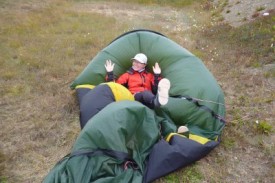 We may not have used this tent for long, but with one week on Exmoor and two weeks in Tierra del Fuego, it's already been through quite a lot of what nature is able to throw at it weather-wise.
We may not have used this tent for long, but with one week on Exmoor and two weeks in Tierra del Fuego, it's already been through quite a lot of what nature is able to throw at it weather-wise.
We set about choosing a new tent carefully, as we wanted to invest in something really excellent which would serve us well for many years to come. After reading many reviews and after a lot of head scratching we decided that we'd go the route of the Hilleberg, much-loved by cycle tourers. Choosing which model of Hilleberg was the bigger challenge. Since we were planning to drag it around the world with us, it had to be many things: reasonably light, very durable (which the Hillebergs are famous for) and big enough camp out in for a few days and accommodate me - at 6'4" (194cm) - and the great array of stuff we like to take with us.
Our old Blacks Octane 3, which we christened Sweaty Betty, did us proud around New Zealand, Denmark and the UK. It was simply too small for the two of us, despite being marketed as a three-person tent, and its ventilation system could have been better.
In the inner section of our old Blacks Octane 3 we were only able to sit up for about a third of the length without touching the 'ceiling' or walls. And my 6'4" made the length rather cramped, and I often found I had wet toes in my sleeping bag due to touching the walls and condensation.
We realised that having straight walls at both top and bottom of the inner section was important to us, so we quickly discounted the popular Nallo GT models which are very commonly used by cycle tourists. We narrowed it down to either a Kaitum, Karon or a Nammatj since they had the straight walls at both ends with very high side walls before they tapered in. The light weight and dual entrances of the Kaitum 3GT eventually won us over. It would cost us the equivalent of a month's rent in London, but we thought it would be worth it.
We were lucky to find a special offer on at Taunton Leisure with a heavily-discounted tent footprint. The tent plus footprint cost us just shy of 1000 GBP.
A few days later our new home arrived, or "The Villa", as some fellow cycle tourists have already fondly named it.
We quickly pitched it out in the communal garden at the back of our flats. It was relatively simple to pitch, with four colour-coded poles which slip quite easily into their housing. We struggled a little with the guy lines at first, but only as we'd not seen this particular system before.
The sheer size of the tent became apparent quite quickly. It's a mega structure at 5.5 metres in length! The size of what was quickly baptised "The West Wing" was almost bigger than the sleeping area in our old tent.
We crawled into its cavernous depths. Peli could actually lie width-ways and I could really stretch out without touching the walls. This was a revelation - the first time in many years I've not felt cooped up under canvas.
The quality of the Hilleberg was clear right away. The number of vents and doors and the good amount of space between flysheet and inner. We've tested these features well: even on a hot day you can unzip the inner vents and get a good breeze going, even with the mosquito nets of the inner tent zipped shut. On cold nights you can zip everything up and not worry about the condensation which plagues many other tents.
 On Hilleberg's website they advise that if you're pitching in the wind, you should point the "East Wing" (i.e. the lower end) into the wind and peg it down before continuing with the rest of the tent. We have successfully done so in the famous Patagonian winds, but it definitely helps to have more than one pair of hands. There is a lot of fabric to the Kaitum and it would be very tricky to put up in the wind if you are on your own. Equally, when taking it down in strong winds, having an extra body to act as an anchor is very handy. Peli tends to lie flat on the poleless parts of the tent while I scurry around taking out the pegs.
On Hilleberg's website they advise that if you're pitching in the wind, you should point the "East Wing" (i.e. the lower end) into the wind and peg it down before continuing with the rest of the tent. We have successfully done so in the famous Patagonian winds, but it definitely helps to have more than one pair of hands. There is a lot of fabric to the Kaitum and it would be very tricky to put up in the wind if you are on your own. Equally, when taking it down in strong winds, having an extra body to act as an anchor is very handy. Peli tends to lie flat on the poleless parts of the tent while I scurry around taking out the pegs.
The tent groundsheet posed us with some problems at first. It felt very taught. But, we discovered that if you affix the groundsheet to the flysheet before you peg out the tent and guy lines the tent is much easier to pitch.
We have pitched it in the middle of the night in heavy rain and wind. I'm pleased to say that it was easy, as we'd done a few trial runs so we had it down to a fine art.
It was such a relief to be able to shelter in the large vestibule, get out of the rain and our wet and cold clothing and snuggle down into our warm and dry sleeping bags. There was more than enough space to do this without making everything else wet, or kneeing each other.
Our Hilleberg Kaitum 3GT has done us proud so far in very challenging conditions and we already love it. We hope it will be with us for some time, and we might even invite you over for a cuppa since there is even room for guests!
Now to a few negatives about the tent, which are mainly as a result of the larger size of this beast of a tent.
The inner tent at two am is a bit of a bugger to unzip with one hand if you are busting to answer a call of nature and trying not to hit your tent companion with a knee or elbow. There is so much flex in the fabric that you need two hands to unzip the inner. There must be some way to fix this issue. On smaller tents we haven't noticed this problem.
The other thing is that the flysheet fabric will flex substantially differently in the cold and heat of the day. So, you will have to adapt the tension of the guy lines as the heat goes up and down. It can flex so much that you have a nice firm tent one minute and a bit later the flysheet is resting on the inner tent. This isn't too good if it's raining. Or, the other way round, you can end up with a tent which is tauter than sheets on a hotel-made bed. In this case, opening the tent doors is difficult, so you can't get out of the tent to take some of the tension out of the guy lines!
Otherwise, this tent is just the bees knees if you are a tall cycle tourer or just like your extra space. At just shy of 4 kilos it is not that much heavier than other much smaller tents. It's easy to pitch - I think we have it down to under 10 minutes if we hurry, but it usually takes about 15 minutes. The price does hurt but it is well worth the investment to have such a reliable and spacious shelter to relax in at the end of a hard day's cycling.
 We were a little concerned about finding suitably large pitches when wild camping, but to date it has not been a big problem. We have to spend perhaps a few more minutes searching for a spot that can accommodate it at over 5 metres, and had to move some stones, branches and other debris to make room, but it is worth that small additional effort. We really only need to worry about finding flat space for the sleeping quarters; it doesn't matter if the vestibules are a bit slopy or stony.
We were a little concerned about finding suitably large pitches when wild camping, but to date it has not been a big problem. We have to spend perhaps a few more minutes searching for a spot that can accommodate it at over 5 metres, and had to move some stones, branches and other debris to make room, but it is worth that small additional effort. We really only need to worry about finding flat space for the sleeping quarters; it doesn't matter if the vestibules are a bit slopy or stony.
Rating:
The first time we pitched our "Villa", in the rain, with the end fully unzipped, we sat down and brewed up, while enjoying the stunning view out of the tent. This certainly made up for the "ouch" on the credit card.
![]()
![]()
![]()
![]()
![]()
LINK: http://www.hilleberg.com
